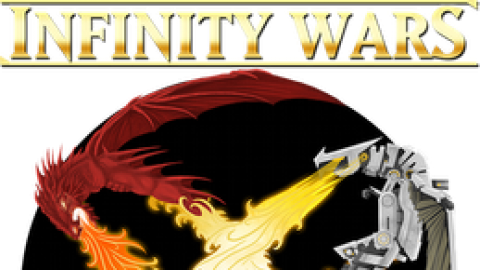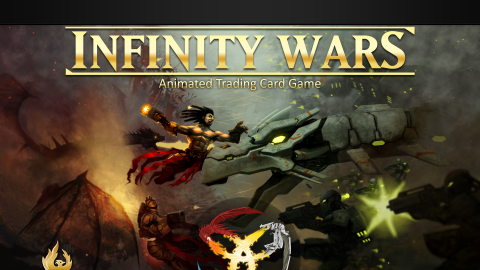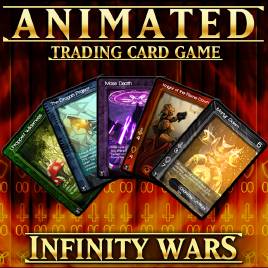Overview
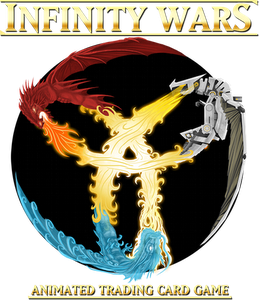
Infinity Wars is a digital trading card game (dTCG) that takes innovative steps to iterate and improve upon the well known genre. The game introduces unique mechanics to evolve trading card games to the next level, while keeping itself familiar enough to veterans of the genre. While many TCGs are considered 'pay to win', Lightmare Studios has taken steps to ensure that every player can start up with ease. They did it using an in-game currency that allows players to purchase any and all cards (slowly - but surely), and by adding game modes that are designed for newcomers. In addition, trading is an option, and the current community is very welcoming and holds plenty of giveaways and the likes to help newer players.
Game-play Mechanics
The first notable difference between Infinity Wars and ye olde TCGs (such as 'Magic the Gathering') is the concept of simultaneous turns. While in most (if not all) other TCGs each player takes his turn knowing what the enemy has done during the enemy turn, Infinity Wars allows various mind games to be played by not knowing what exactly is your opponent planning for you in the current turn. This leads to each player attempting to 'read the mind' of the opponent by viewing the current state of the (digital) game board and trying to figure out what the enemy thinks you might do and how he might respond to that. This leads to a lot more tension, and no real down-time while waiting for the opponents turn to end.
The second notable difference in this take on TCGs is the resource management. While in most old-school games the resources (mana, lands, and the likes) heavily depend on luck of the draw, Infinity Wars grants a certain amount of resource that add up to each player's resource pool on each turn. The basic pace of resource gains is one per turn, but some game modes can change that (such as the 'Hyper' game mode which increases the resource addition to two per turn). This leads to less dependency on luck, less frustration with top-deck, and a lot more control and tactical planning. While each player does get a basic amount of additional resources each turn, there are ways to increase those resources via specific cards (such as Wealthy Noble) or the in-match 'Trade Post' (read below for more).
The third big iteration the game takes is allowing more control over top-deck draw by introducing the in-match 'Trade Post'. This serves as a way to spend 'spare' resources, or use your resources to draw more cards (by either discarding a card from your hand for a cheap resource cost and draw a new one, or by using more resources for a 'no-discard' card draw). In addition, the Trade Post allows the player to increase his resource pool once the match gets to the later rounds.
The fourth iteration is the addition of Morale as a win-condition. While the game has the basic concept of Health, a second and just as important resource that needs to be kept above 0 is Morale. As characters die, a player will lose his Morale points slowly. Each character has its own Morale cost (listed under the resource cost). Some characters and abilities or Locations (see below regarding Locations) may have different effects on Morale, such as gaining Morale when a specific character you control dies, or making the enemy lose Morale if he fails to kill one of your characters while damaging it. Certain decks rely heavily on the Morale resource, while others are rather weak on that front due to reliance on plenty of character cards or expensive character cards. Morale is also lost once a player 'Decks Out' (runs out of cards to draw), at the rate of 10 Morale lost on each turn the player cannot draw a card.
Another huge iteration is the re-imagination of the game-board. The board in Infinity Wars is divided into different Zones, with each having unique characteristics that allow a diverse game-play:
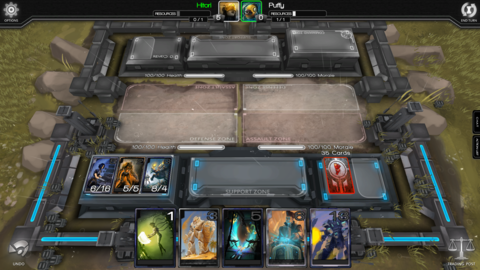
- The Command Zone, where each player has three character cards (creature cards in 'Magic' terms) that are in play, but not in the battle per-se. These characters can be played directly into the Combat Zone without being Exhausted (in 'Magic' terms, summoning sickness). In addition, the commanders can use their character abilities from the Command Zone without being put on the front-lines of battle, thus reducing the risk and allowing very strategic planning of character ability usage.
- The Support Zone, where most characters find themselves once they have been played. Exhausted cards are put into the Support Zone, where they cannot attack or block but are still relatively exposed to damage, control-abilities and other such risks. A player can also put non-Exhausted cards in the support zone as a mean to counter specific control-abilities, or simply to avoid the characters from taking part of the combat this turn.
- The Assault & Defense Zones, these are the front-lines, where battle takes place and everything is exposed and at risk of being destroyed, killed or controlled. The characters on each player's Assault Zone face against the ones on the opponents Defense Zone, which allows a varied control over how the combat flows. If you are being pressured into a corner you may wish to focus all your resources on the Defense Zone, while if you are playing from an aggressive footing you can go all out Assault. Most of the time there will be a certain balance between the zones as each player tries to defend his health pool and Morale while damaging the opponent. The order in which characters are placed within the Assault & Defense zones is of major importance, as it determines which characters attack or defend first. One must take into account that fact when thinking of how to react to his opponents cards, and try and guess where his opponent will place each card in a specific order to try and eliminate his defenses or assault. Each attacking character attacks once (unless it is specified otherwise), while each defending character defends until it dies (and then damage goes to the next character, or to the opponent's health pool).
Commanders also determine the 'Purity' of a player's deck. In addition to their tactical role, they limit and regulate which characters and abilities a player can place in his deck. While in games such as 'Magic the Gathering' a player needs specific kinds of resources to cast specific creatures and abilities, the resources in 'Infinity Wars' are 'color neutral' and allow you to cast whatever characters or abilities you may choose. The commanders limit the cards able to be used in a deck by using a 'Purity' mechanic. To have a card of a certain faction in the deck, one needs a corresponding faction's commander. Purity goes from one purity for the most average cards, to two and three purity to more unique and often stronger cards. For a deck to have a card that requires 3 purity of a certain faction, a player needs all three of his commanders to be of that faction (2 purity for two corresponding commanders, and 1 for one). This allows players to merge different factions, while limiting how strong or unique the cards they use from that faction are, the upper limit being three different factions corresponding to the three commanders. In the current meta players are often using 2 factions with one being the dominant faction and the other being the supportive faction for the most part. Ability cards cannot serve as commanders.
Another important card type is the 'Location' card type, which affects the game-play but also changes the way the game board looks (animation wise). Locations can do various things, and act somewhat similar to Enchantments (specifically: 'Enchant World') in 'Magic the Gathering'. Some can make other abilities and characters cost less to cast, while others can be used to build up enormous creatures or even act as alternative win conditions. A player can only have one Location card in-play, playing another would result in the destruction of the current one. In addition to Location cards, Infinity Wars have 'Artifact' cards which are similar to Artifacts in MTG. These aren't limited like Locations, and each player can have multiple ones in play.
Decks are limited in various ways. A deck may not contain more than 3 copies of the same card, except an 'Unlimited' card .This excludes the commanders, allowing up to 6 copies of a character card to be in the deck so long as three of them are commanders (5 copies with two as commanders, 4 with one commander). 'Unique' characters are cards that can only appear once on each player's side of game board (excluding specific bypassing methods). These 'Unique' cards can only be used once as a commander, since they cannot break the 'Unique' effect, thus allowing up to a total of 4 copies to be in the deck. Currently, each faction has one card that is an 'Unlimited' card, which can have as many copies as the amount of copies you own in the deck. these cards are usually the backbone of the deck and showcase the deck's play-style. Decks are currently required to have at least 40 cards, excluding commanders, in all game modes (read below).
To allow abilities and character casting to be resolved in an orderly fashion within the simultaneous turn format, Infinity Wars uses an 'Initiative' mechanic. At the beginning of the match a player is chosen with a randomly to have the initiative on the first turn. After the first turn, each player gets the initiative every other turn. Initiative is of great importance as it determines who's abilities and characters are deployed first, and also who's assault goes off first. For example: If player A has the initiative and plays an ability that makes a character 'Untouchable' (in 'Magic' terms, 'Hexproof'), and player B plays an ability that removes that character from the game by targeting it, player B will lose his targeted ability and the character would remain in play. If the initiative was reversed, player B's ability would be cast before player A's, and thus the character would be lost and so will the ability card he used to make it 'Untouchable'. There is one card type that (mostly) ignores initiative, it is called 'preemptive'. Cards that are preemptive take place before any and all other abilities, though it does take initiative into account if both players used preemptive abilities (the initiative will determine which preemptive ability activates first). Initiative has plenty of minor elements within it and to grasp it more completely takes experience and knowledge.
In addition to all of the above, Infinity Wars takes pride in being a fully animated dTCG in which each and every card has a unique animation that is shown while zooming in on the card. This livens up the game-play by a significant amount and combined with the simultaneous turns mechanic makes the game much more vibrant than other dTCGs.
All of these mechanics combined create a very unique game in the landscape of TCGs, while keeping it familiar enough for any veteran or casual of such games to jump right in (after a quick tutorial to help settle in).
Turn Resolving Order
With turns being simultaneous, the order in which abilities, characters and character abilities are activated is extremely important.
- Draw Phase: Draw one card, or more, depending on your game speed and card drawing abilities.
- Start of Turn: This is when 'at the start of each turn' abilities take effect.
- Planning Phase: Plan your actions for this turn. The order in which you cast abilities and deploy characters matters once you finalize your choices, so choose carefully.
- Resolution Phase: Planning gets executed. The player with the initiative has his characters, abilities and assault go off first. Resolution phase is split into different segments (listed below).
- End of turn: This is when 'at the end of each turn' abilities take effect.
Resolution Phase Breakdown:
- Deployment of characters onto the battlefield.
- Battlefield maneuvering. Characters in the assault, defense, and support zone move around as planned by the player.
- Preemptive abilities take effect. This includes abilities such as 'Deflect'.
- Character entrance abilities take effect. This includes abilities such as 'When Lucca comes into play, all artificial creatures you currently control get +4/+4'.
- Character activated abilities AND ability cards take effect. The order in which players use those abilities determines the order in which they take effect. If a card that would make a character 'Untouchable' is cast before another ability is used on that character, the other ability will not take effect. This includes initiative as well as your personal casting order (so make sure to make a character Untouchable only once you used all other abilities you wish to be placed on it).
- Assault. The attack and defend phase, the player with initiative attacks first while the player without it defends first.
Game Modes & Game Speed
With the game is still in beta, there are already several different game modes and speeds, some more familiar to the experienced TCG player, some completely new.
Game Speeds:
- Standard: Each player draws one card each turn, and adds one resource each turn to his resource pool.
- Hyper: Each player draws two cards each turn, and adds two resources each turn to his resource pool.
- Epic: The base Morale and Health pools are doubled (going up from 100 to 200), while keeping the standard draw and resource rules.
Game Modes:
- Unranked Constructed: Each player uses his own deck (40 cards minimum).
- Ranked Constructed: Each player uses his own deck (40 cards minimum), this game mode works around an ELO system with a leaderboard.
- Merged Deck: This mode is very 'newbie' friendly and takes both players decks (40 cards minimum each), shuffling them together into a single card pool that both players draw from. Each player can choose 3 commanders from the shared pool of 6 commanders that are in the decks of both players.
- Pauper: The pauper game mode forces players to compete with only the 'Common' & 'Uncommon' card types, thus making it easier for new players to participate in these matches, while also allowing veterans somewhat of a creativity challenge by building a deck around cards of lower quality. Each player uses his own deck (40 cards minimum)
- Rift Run (arena draft): Each player gets 43 rounds of 4 cards to draft his deck from and picks 1 card in each round. First 3 are the commanders, the rest are the deck. Rift Runs require the player to pay an entry fee either using in-game currency or real money, at the end of the run (after 3 losses) players get rewarded with in-game currency and other rewards depending on how well they did (a Rift Run can go through an unlimited amount of games, but only 3 losses). At the end of the run players are able to purchase the deck they drafted for either in-game currency or real money, with a discount to the price depending on how well they did in their run.
Excluding the Rift Run (arena draft) and the Ranked Constructed modes, these game modes and speeds can be combined (one game speed combined with one game mode), creating various interesting match types for the players to play.
Factions
Currently the game has 6 official factions, or 'colors' (ones that have purchasable decks for) and one additional faction that does not have a complete pre-made deck just yet:
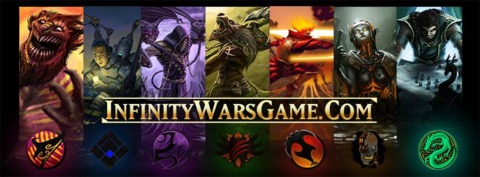
- Genesis Industries: A combination of humans and artificial beings that complement each other. The faction utilizes tinkering and constructing mechanics which allow each artificial character to be used as pump-up material for other characters by sacrificing it, or to be buffed slightly without need of a sacrifice (all this utilizes non-artificial characters' abilities). This faction is very versatile and can go for a very strong single character by focusing all the character pump on a single card, or spreading the buffs around and create an army of small to medium characters.
- Warpath: A beast based faction, not unfamiliar to those who played 'Magic' (corresponding to the green color). This faction relies on medium characters and pumping and/or breeding them to create either stronger characters or more characters. Warpath has a few various ways to 'breed' its characters and create a large army that can be later on pumped, or simply used as chump blockers or endless assault of small to medium characters.
- Flame Dawn: A very aggressive faction, somewhat corresponding to the red faction in 'Magic' (more towards the Goblin decks than the Burn decks). This faction works on characters that are cheap to cast, and quick to attack using the 'Charge' mechanic (similar to 'Haste' in 'Magic'). An early-aggro faction for the most part, these guys are ideal for those that wish to slay their enemies before the opponent has a chance to respond.
- Cult of Verore: A heavy control focused faction, this is a death cult that depends heavily on damaging-abilities and zone-control abilities. They inflict a lot of damage using abilities (either ability-cards or character abilities), and use that damage to control the flow of battle until they are ready to finish off their opponent. This faction is somewhat similar to both the Blue (control) and Red (burn) colors in 'Magic the Gathering'.
- Descendents of Dragons: A faction which is based on heavy defenses and alternate win conditions (most notably - Morale). This faction relies on making sure the enemy will not kill your characters, while making him lose Morale for failing to kill your characters. They tend to try and win based on Morale instead of Health, but they can shift their focus towards the late game to go for a heavier assault if required.
- Sleepers of Avarrach: Sleepers are a zombie faction, with all that it entails. They rely on Graveyard fetch, character resurrection, and infecting the enemy characters to take control of them. They usually become much harder to stop in the later phases of the game due to characters amassing in the Graveyard.
- The Exiles: The Exiles are a chaotic faction, based on demons. They rely on a lot of self-discard mechanics which allow them to use their ability (called 'Exile') that is comparable to Magic's 'Madness' ability. The ability 'Exile' allows you to cast the card from your graveyard a turn AFTER it was discarded from your hand, for a cheaper price than it normally costs. Apart from this ability, the exiles have the 'Consume' ability, that allows character to grow stronger and heal after each kill they get in combat.
- In addition there are factionless cards that can go into any deck (they do not require a commander purity). These are usually somewhat weaker but generally needed cards that fit into various decks. They exist as a way to allow all factions access to general useful tools (that usually aren't too specific, or cost a bit more than a faction specific card that fills a similar role).
Lore
The original world, or the 'old world', of Infinity Wars has suffered a calamity in the past. That calamity is tied directly to one of the characters that makes an appearance in multiple factions, Aleta. She is an immortal being that doesn't age and, if killed, regenerates.
After the calamity the world has been split into multiple realities (potentially an infinite amount), with each of these being home to one or more of the game's factions:
- The world 'Talich' is home to the factions Flame Dawn and Genesis Industries.
- The world 'Reisch' is home to Descendants of Dragons and Cult of Verore.
- The 'old world' is home of Warpath.
- The world 'Avarrach' is home to the sleepers.
Location cards within the game also correspond to locations within the worlds -
- Pyr is the home base of Aberrion, a leader (or the leader) of the Flame Dawn.
- Veroria is the home base of Aleta, Immortal Sorceress - leader of the Verore.
- Hellmouth (a Verore location) is the entrance to the realm of hell. The hell realm was not split to multiple realities like the world itself, and remains intact.
- 'The Dragon Project' is a secret weapon being developed by Genesis Industries (led by Orion).
Little more is currently known about the lore of the game, but more details should come to light once the game releases. Generally speaking the lore can be found across flavor text on many various cards, an example would be Aleta (in her various faction appearances).
In-Game Shop And Monetizing
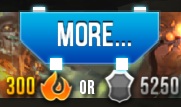
Infinity Wars allows players to earn their cards or decks by playing. It does so by having an in-game currency that allows all of the pre-made decks and even booster packs to be purchased. The game also includes plenty of free rewards (that are Account-Bound so they can't be traded) that allow players to be introduced of the cards faster (those cards can be obtained through the leveling process, the weekly quests, and the daily log-in & daily-match rewards). Lightmare are currently monetizing mostly off cosmetic items, such as avatars, card sleeves (card backs) and battlefield cosmetics. The ability to spend real money to buy cards is implemented, but is not enforced whatsoever. There is only one card pack that isn't obtainable with the in-game currency, which is a collection of cards from different factions that receives a heavy discount for new players (all cards in this pack can be obtained through other means). There are no cards that require cash to obtain, and none are planned either, according to this latest statement:
THERE WILL NEVER BE EXCLUSIVE CARDS THAT ONLY A SELECT FEW CAN EARN.
-Teremus, Lightmare Studio's Community Creator
27.07.2013
Tournaments & Other Events
While the game is still in an early build, and officially in beta, Lightmare already launched (and by now concluded) the first competitive tournament. Participation was open for all players for an entrance fee of Lightmare Points (cash) with the grand prize being a rather large sum of Lightmare Points and in game currency. There are also community driven tournaments as well, some using the 'Pauper' format to make them more accessible for new players and new ideas.
Infinity Wars also has quests that change periodically, these award extra in-game currency, extra cards (usually from an upcoming expansion), and may provide additional rewards in the future. The quests can present various challenges, such as winning a game without casting any ability card and other such examples.

 Mac
Mac PC
PC